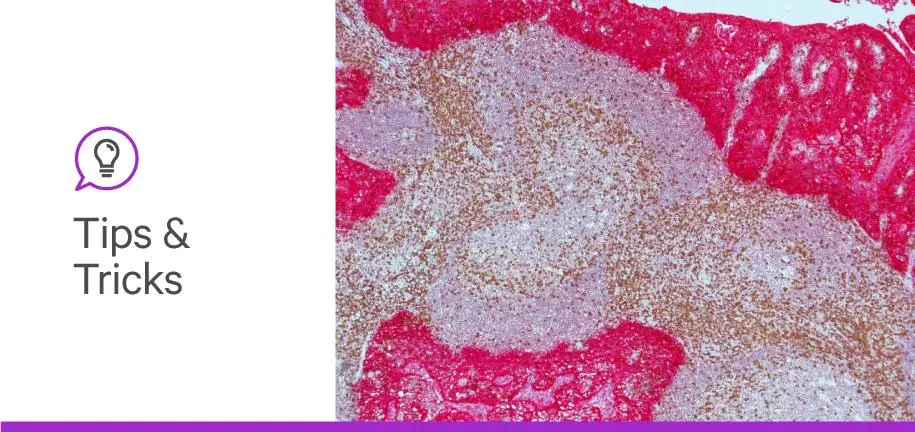
Vector Laboratories is closed for the President’s Day on Monday, February 19th. We will be back in the office on Tuesday, February 20th.
We will respond to emails upon our return. Have a wonderful day.
Menu
Vector Laboratories is closed for the President’s Day on Monday, February 19th. We will be back in the office on Tuesday, February 20th.
We will respond to emails upon our return. Have a wonderful day.

When it comes to your tissue samples, you want what is most optimal for them. You spend many laborious hours ensuring the idealconditions are met to preserve your sample after harvesting and grossing. If you go the paraffin-embedding route, you formalin-fix your sample, dehydrate it in a series of alcohols, clear it in xylene, and finally embed the tissue in paraffin. If you decide cryopreservation is more suited to your needs, you fix your sample, mount it in a block of OCT compound, and finally freeze it in liquid nitrogen chilled, isopentane, or dry ice. Either way, after you have a block of tissue, you are left with a sample that requires sectioning to pursue activities such as immunohistochemistry (IHC) or immunofluorescence (IF) staining. The last thing you want to happen after all that work is to lose your precious sample during subsequent sectioning or staining. We’re here to help you retain the best stained slides possible. Keep reading for tips, and if you need help with other steps of the sample prep process, be sure to check out our Staining Sample Prep Guide.
You want to get the most out of your tissue sections, whether it’s to obtain a beautiful image or to quantify data. Keeping your tissue sections adhered to your slides is essential in obtaining the best results. If you decide to use paraffin-embedded tissue, then after sectioning, slides need to air dry for approximately 24 hours at room temperature or in an oven at 50–60°C for 1 hour. It is essential to closely monitor tissue drying in the oven as extended slide drying at high temperatures may decrease immunogenicity (1). Some tissues can also benefit from being heated at 50°C on a slide warmer for 30–60 minutes to avoid any possible detachment of specimen from the slide.
Using chemical adhesive reagents, such as VECTABOND® Reagent, can also help the tissue to stay attached to the slide throughout the workflow, even when it involves extreme conditions (e.g., in situ hybridization or high-temperature antigen unmasking). The great thing about VECTABOND is you can use it for paraffin-embedded and frozen tissue sections or cell preparations to increase the adherence to glass slides and coverslips. VECTABOND works by chemically modifying the surface of the glass with positive charges to form a highly adherent surface. The process of using VECTABOND-coated slides is easy and fast. Simply follow the steps below:
For frozen tissue, allow your sections to dry on VECTABOND-treated slides before fixation and storage, then process as usual.
Once you have reached the end of your sample sectioning and preparation process, IHC/IF staining might be the next step. If that is the case, you want to ensure you have uniformlystained sections. Not only do you want a standard level of reagent penetration across your samples, but you don’t want to waste reagents in the process. The solution to this situation is to apply a hydrophobic barrier around the sections. Creating such a barrier around each section allows for the use of different reagents between sections on the same slide as well as reducing the volume of reagent needed to cover the sections. This in turn has the added benefits of flexibility and cost reduction for your experiments. Traditional methods are messy and time-consuming, but using an ImmEdge® Hydrophobic Barrier PAP Pen is a much easier way of creating a hydrophobic barrier. It is stable for use with buffers with and without detergent (Tween 20, Triton X-100, etc.), compatible with enzyme or fluorescence-based detection systems, and soluble in all commonly used clearing agents. The process of using the ImmEdge PAP Pen is a breeze. Simply follow the steps below:
Not convinced how easy it is to use the ImmEdge PAP Pen? Watch the video at the bottom of the article to see how it’s done.
Conclusion
Now you’re all set to create stained slides without fear of losing your sections or wasting reagents on your tissue sections. These tips will allow you to get the microscopy images of your dreams and help in your data-collecting goals. Check out our Immunohistochemistry Resources Page for more information and stay tuned for more tips and tricks from the SpeakEasy Science Blog.
References





Stay in the Loop. Join Our Online Community
Together we breakthroughTM

©Vector Laboratories, Inc. 2024 All Rights Reserved.